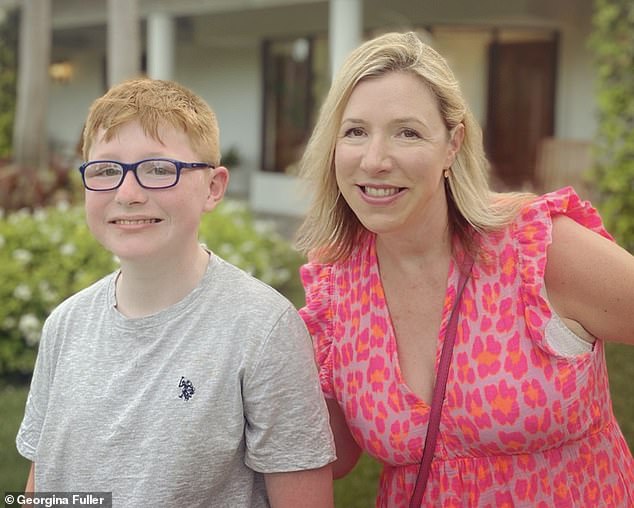When my now 13-year-old son Eddie was being assessed for autism back in 2019, I remember blurting out to the UK clinical psychologist, “Pathological Demand Avoidance? What exactly is that?” The term was completely new to me, and honestly, a little intimidating.
The “A-word” had been whispered when Eddie was a toddler, thanks to his speech and learning delays, but we only finally got around to joining the NHS waiting list for an assessment after a particularly difficult first year at school.
Eddie struggled with simple instructions, understanding phrases like “use your inside voice,” and despite having a completely normal IQ, he couldn’t hold a pencil, write his name, or handle the chaos of a busy playground.
He also has a visual impairment and wore an eye patch but refused to sit at the front of the classroom, making it hard to read the blackboard.
Sometimes he would even fall asleep mid-class. I became all too familiar with being called in to pick him up.
Early Challenges and Parental Adjustments
Growing up in the 1980s and 1990s, when autism and ADHD weren’t widely discussed, I hesitated to seek a diagnosis for Eddie.
But it became clear early on that he was very different from our other two children, Charlie, now 16, and Jemima, 11.
Mornings were a ritual: I helped him get dressed, brush his teeth, and laid out his breakfast separately because he couldn’t tolerate the sounds of his siblings eating, even with noise-cancelling headphones.
He refused milk on his cereal, so that went in a glass instead.
Alongside his autism diagnosis, Eddie was diagnosed with Pathological Demand Avoidance (PDA), a profile characterised by extreme anxiety-driven avoidance of everyday demands, and Sensory Processing Disorder (SPD), which affects how sensory information is perceived and processed.
I understood SPD—he’s sensitive to clothing labels, noise, and textures—but PDA was a whole new world.
Learning from Other Parents
I thought of Izzy Judd, a violinist and mother-of-three, who shared her experience with PDA on Dr Alex George’s Stompcast podcast.
Married to McFly drummer Harry Judd since 2012, Izzy explained that parenting a child with PDA meant rethinking rigid routines entirely.
“Pathological Demand Avoidance is linked with autism,” she said. “It’s about demands that trigger underlying anxiety in the child.”
Even everyday tasks like getting dressed or brushing teeth could cause upset, so Izzy stopped giving direct commands.
To outsiders, this approach might look like lazy parenting, but as she explained, it’s about avoiding overwhelming the child and respecting their autonomy.
Finding a Balance at Home
I relate deeply to that perspective. Some weekends, Eddie comes downstairs in pajamas while the rest of the kids head out for football or horse riding, and yes, he might spend most of the day on his tablet.
Forcing him to join in usually leads to meltdowns or arguments.
One activity he does enjoy is walking the dogs with me. I give him plenty of notice—usually an hour—so he can mentally prepare.
Sometimes I offer alternatives, like a walk to the café at the top of the hill where he can have his favourite carrot cake.
Over time, I’ve learned that autonomy is essential for children with PDA—they need to feel in control of their day.
Navigating Holidays and Unexpected Challenges
Even with careful planning, situations can go awry. On a recent last-minute island holiday, Eddie struggled with the ferry’s noise and refused to get out of the car at the beach.
My partner and I took turns keeping him company while the other kids swam.
For neurotypical children, rules, boundaries, and consequences often work—but for Eddie, these approaches usually backfire.
Natalie Long, a neurodiversity consultant, explains that PDA children aren’t defiant or manipulative; their resistance is rooted in anxiety.
Even a simple request like “put your shoes on” can trigger a fight-or-flight response. Understanding this distinction is key to supporting them.
Shifting Parenting Approaches
Ms Long advises parents of PDA children to move from a “control and compliance” mindset to one of collaboration and connection.
Traditional strategies such as rewards or strict boundaries often increase anxiety.
Instead, she suggests building trust, offering choices, and creating a sense of safety.
Celebrating small wins and reducing unnecessary demands helps children feel more comfortable.
For Eddie, routine is crucial. His weekday mornings follow a strict schedule—washing, breakfast, teeth brushing—which makes life smoother. Weekends and holidays, however, remain more challenging.
Activities like Lego and swimming, which he enjoys, have been invaluable.
Seeing Beyond the Behaviour
What might look like rudeness or defiance at a friend’s party is often a PDA response. Ms Long highlights that children with PDA frequently possess creativity, empathy, and insight.
In the six years since Eddie’s diagnosis, I’ve learned that PDA is real, pervasive, and something we navigate daily.
It’s part of him, but it’s not an excuse for poor parenting—just an important lens for understanding and guiding him.
Expert Insights on PDA
Hannah Lewis, counsellor and psychotherapist at Compare My Health Insurance, explains that PDA children resist even activities they enjoy because the perception of being “told” what to do triggers intense anxiety.
“It’s not about stubbornness; they need to regain a sense of control when overwhelmed,” she says.
Sarah Jeffries, founder of Paediatric First Aid, adds that resistance stems from a protective response.
Even ordinary requests can feel threatening.
By recognising that behaviour as anxiety-driven, parents can adopt more flexible strategies: using humour, offering choices, and collaborating with the child rather than imposing expectations.
Moving Towards Calm and Connection
Although emotionally and physically exhausting, understanding PDA fundamentally changes family dynamics.
Empathy replaces conflict, trust grows, and daily life becomes more manageable.
For Eddie and our family, these strategies have made all the difference—turning what might appear as challenging behaviour into a deeper understanding of his world.
Share on Facebook «||» Share on Twitter «||» Share on Reddit «||» Share on LinkedIn